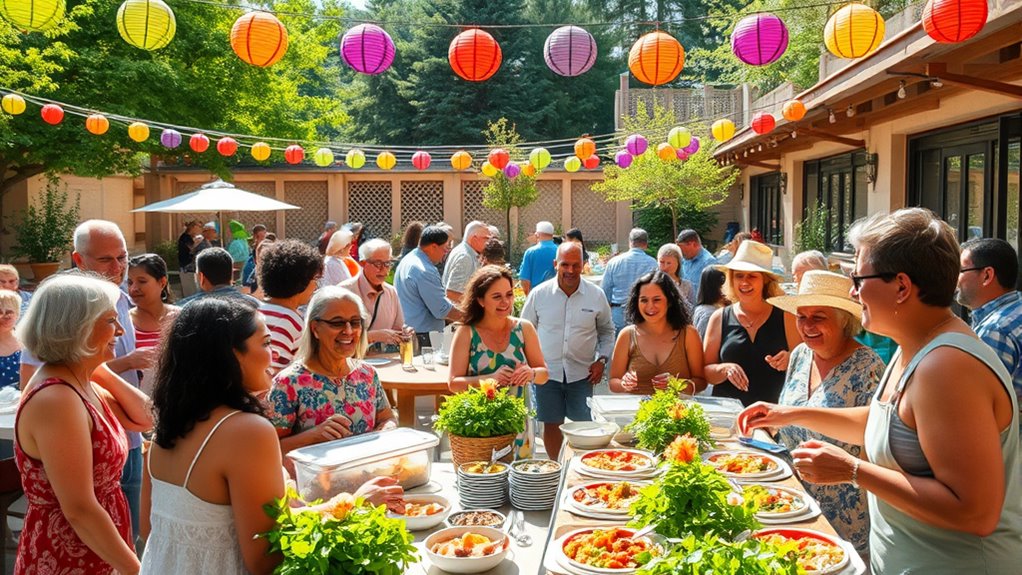To host inclusive events, prioritize cultural awareness and accessible planning to make all guests feel valued. Incorporate features like ramps, clear signage, and sensory-friendly options, while using simple, inclusive language paired with sign language support and visual aids. Train your staff to handle diverse needs respectfully and gather feedback to improve. By focusing on these practices, you’ll create welcoming spaces for everyone—continue exploring how to make your event truly inclusive.
Key Takeaways
- Prioritize diverse representation and cultural awareness in event planning to create respectful, inclusive spaces for all guests.
- Ensure physical and sensory accessibility through features like ramps, quiet zones, and sensory-friendly activities.
- Use multiple communication formats, sign language support, and simple language to accommodate varied impairments and language needs.
- Train staff on cultural competency, inclusive communication, and handling diverse social norms with sensitivity and respect.
- Collect and act on attendee feedback to continuously improve inclusivity and demonstrate commitment to diverse guest experiences.
Understanding the Importance of Diversity and Inclusion
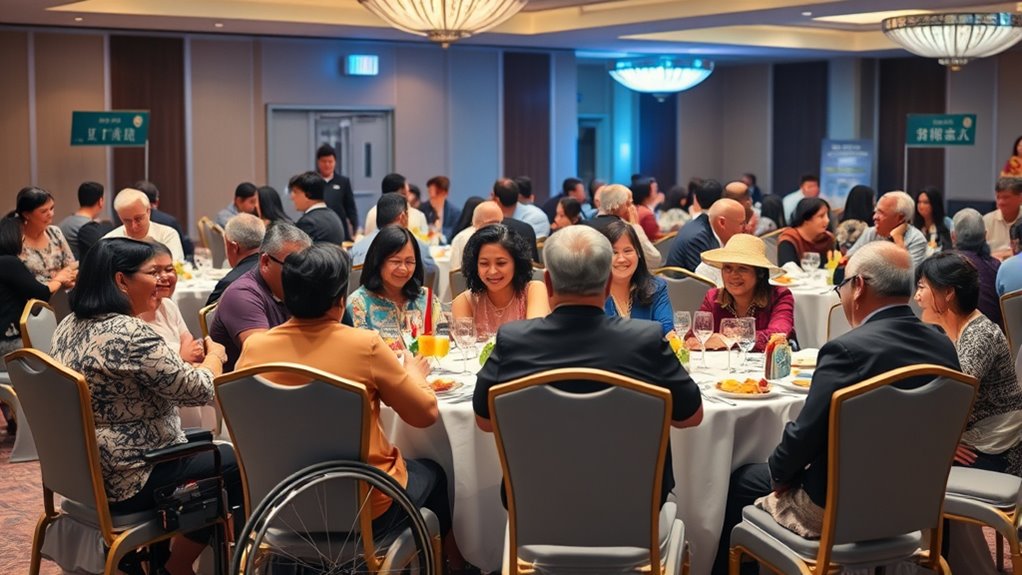
Understanding the importance of diversity and inclusion is essential because it directly impacts the success and relevance of your events. When you prioritize cultural awareness, you create a space where all guests feel valued and respected. This awareness helps you recognize different backgrounds, perspectives, and traditions, enriching the event experience. Additionally, focusing on bias reduction allows you to identify and challenge unconscious prejudices that might otherwise exclude or marginalize certain groups. By actively promoting diversity and inclusion, you foster an environment where everyone can participate fully. Incorporating cultural intelligence insights can also help tailor experiences that resonate with diverse personal beliefs and preferences. Cultivating an environment of equity and representation ensures that all guests see themselves reflected and appreciated. Understanding how diverse designs and materials can enhance inclusivity further supports creating welcoming spaces. Ultimately, understanding these principles ensures your events are meaningful, impactful, and truly inclusive.
Planning With Accessibility in Mind
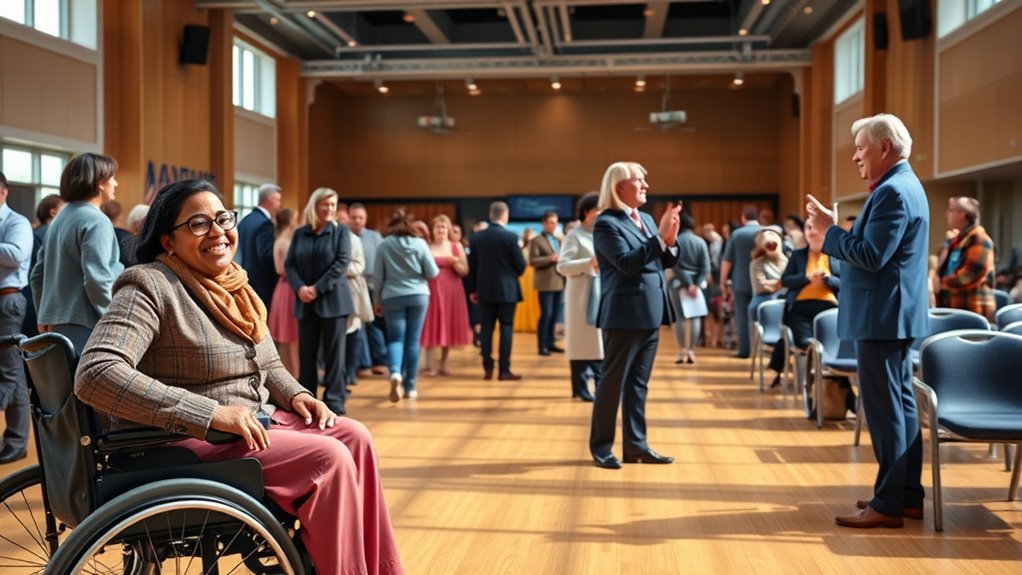
When planning your event, consider accessible venue features like ramps, wide doorways, and clear signage to accommodate all guests. Use inclusive communication strategies, such as plain language and multiple formats, to guarantee everyone understands and feels included. Incorporating multimedia formats like videos and podcasts can further enhance accessibility and engagement for diverse audiences. Additionally, integrating aquatic exercise activities or water-themed entertainment can create a relaxing and inclusive atmosphere that appeals to a wide range of guests. Incorporating security considerations such as well-lit areas and effective emergency procedures can also help ensure the safety and comfort of all attendees. Ensuring that the venue is properly cleaned and maintained can prevent health issues and promote a welcoming environment for everyone. By focusing on these elements, you create a welcoming environment where everyone can participate fully.
Accessible Venue Features
To guarantee your event is truly inclusive, you need to prioritize accessible venue features from the start. Ensure signage placement is clear and strategic, guiding all guests effortlessly through the space. Proper signage helps those with visual impairments or cognitive differences navigate confidently. Equally important is ensuring wheelchair accessibility throughout the venue, including entrances, restrooms, and seating areas. Check that doorways are wide enough and that pathways are free of obstructions. Incorporate ramps where needed and verify that flooring is even and non-slip. These features demonstrate your commitment to inclusivity and make your event welcoming for everyone. When you plan with accessibility in mind, you create an environment where all guests can participate comfortably and without barriers. Additionally, understanding necessary cookies ensures you provide essential features like secure access and basic navigation support for all attendees. Incorporating universal design principles can further enhance accessibility by creating adaptable spaces that accommodate diverse needs naturally.
Inclusive Communication Strategies
Planning your event with accessibility in mind means adopting inclusive communication strategies that reach all guests effectively. Incorporate sign language interpreters or provide real-time sign language services to ensure deaf guests can fully participate. Use visual aids like slides, captions, and large-print materials to support guests with visual or cognitive impairments. Keep language clear, simple, and direct to avoid confusion. Offer materials in multiple formats—digital, print, or audio—to accommodate diverse needs. Ensure that all communication is visible and accessible from various angles, and consider using assistive listening devices if necessary. Additionally, understanding the importance of color accuracy in projectors can help in selecting visual aids with optimal clarity and contrast, enhancing overall communication. Familiarity with legal processes can inform your planning to ensure inclusivity in diverse contexts. Being aware of cookie categories and their functions can also inform the choice of accessible digital materials and ensure compliance with privacy preferences. Recognizing the financial aspects involved in organizing events can help in allocating resources effectively to support accessibility initiatives. By integrating these strategies, you create an environment where everyone feels informed, valued, and included, making your event truly welcoming for all attendees.
Creating an Inclusive Communication Strategy
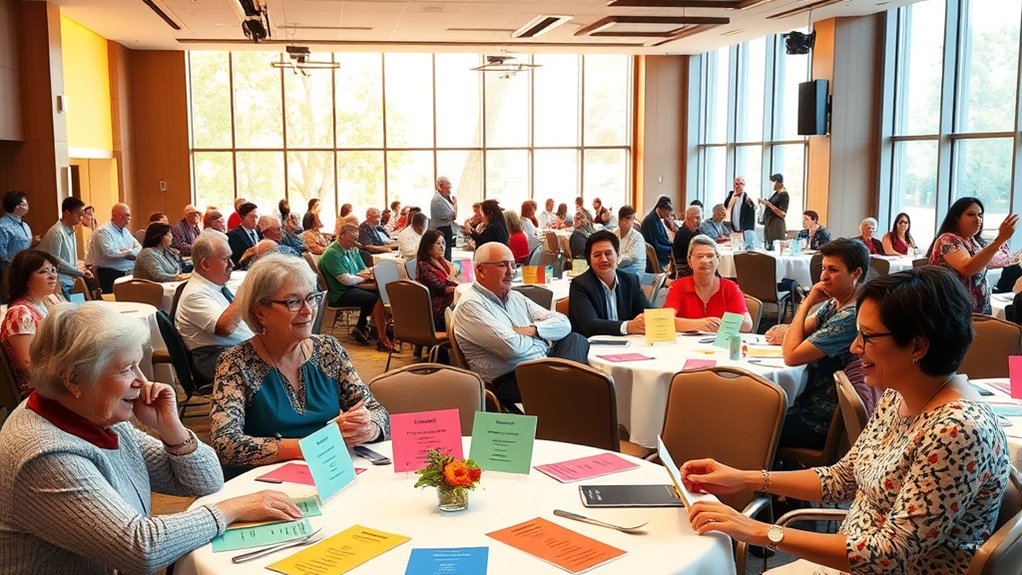
How can you guarantee your communication actively promotes inclusivity? Start by ensuring all your messages are accessible to everyone. Use sign language interpretation during live events or presentations to support deaf guests. Incorporate braille signage throughout the venue to assist visually impaired attendees in *orienteering* spaces independently. Keep language simple, clear, and free of jargon to accommodate diverse literacy levels and cultural backgrounds. Make sure your printed and digital materials include alternative formats, like large print or audio descriptions. Encourage staff to be mindful of inclusive language and to be aware of different communication needs. Additionally, understanding the importance of rendering lard can foster empathy and connection among your audience. Recognizing the best gelato in Laguna Beach can also serve as a delightful way to connect and create shared experiences. Being aware of various vehicle tuning options, such as Kia Tuning, can help you better understand diverse preferences and needs, fostering a more inclusive environment. By proactively addressing these aspects, you create an environment where all guests feel valued, understood, and comfortable participating fully in your event.
Designing Activities That Celebrate Different Perspectives
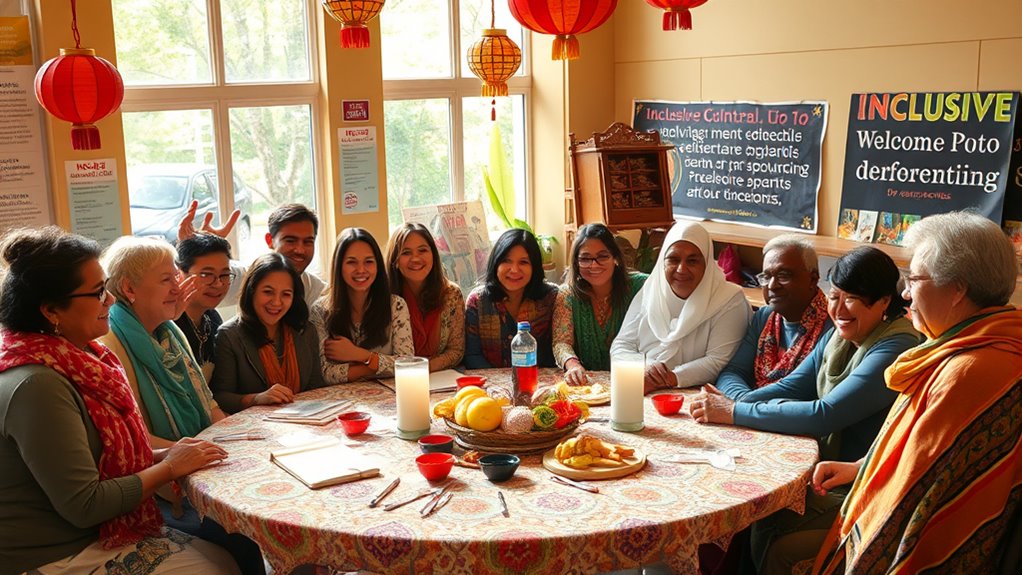
Building on your inclusive communication efforts, designing activities that celebrate different perspectives guarantees all participants feel seen and valued. Incorporate intergenerational engagement by creating opportunities for people of all ages to share experiences and learn from each other. This fosters mutual respect and broadens understanding. Additionally, include sensory-friendly activities to accommodate guests with sensory sensitivities, ensuring they feel comfortable and included. These activities could involve quiet zones, tactile stations, or visual arts that allow participants to express themselves without feeling overwhelmed. Incorporating air quality improvements into your event space can also enhance comfort and well-being for attendees with allergies or sensitivities. By thoughtfully blending different perspectives into your event’s activities, you encourage meaningful interactions and promote inclusivity. Remember, the goal is to create spaces where everyone’s background and needs are recognized, celebrated, and integrated into the experience.
Training Staff and Volunteers for Inclusive Engagement
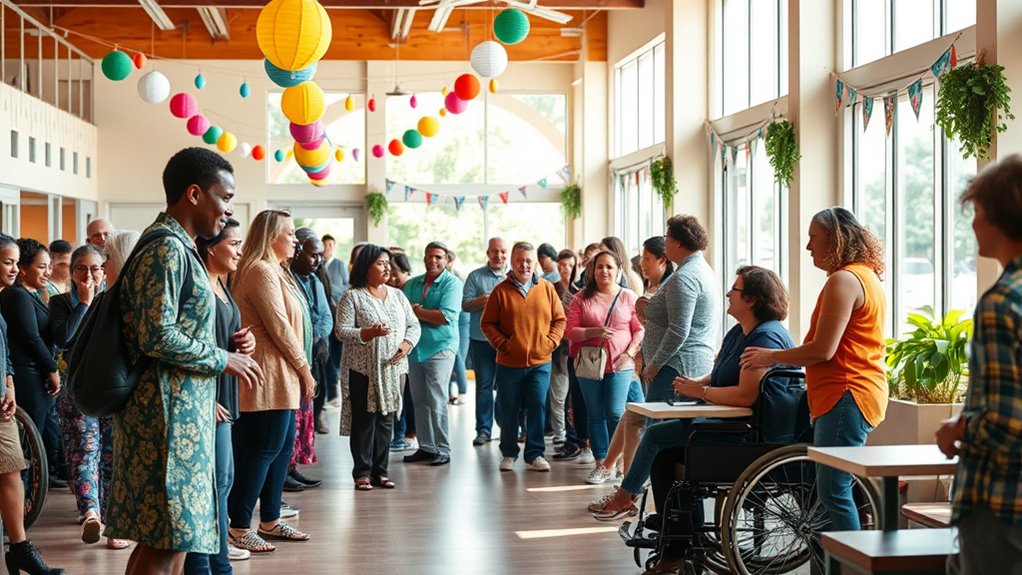
To guarantee your staff and volunteers foster an inclusive environment, you need to focus on cultural competency development and inclusive communication strategies. These skills help your team understand diverse perspectives and connect effectively with all attendees. Investing in targeted training prepares your team to handle a variety of situations with sensitivity and respect.
Cultural Competency Development
Training your staff and volunteers in cultural competency is essential for creating truly inclusive events. When they understand cultural sensitivities, they can better recognize and respect diverse backgrounds, making all guests feel valued. Addressing language barriers is also critical; equip your team with basic phrases or translation resources to facilitate communication. By fostering awareness of different customs, traditions, and social norms, your team can navigate interactions with empathy and respect. This training helps prevent misunderstandings and unintentional offenses, creating a welcoming environment for everyone. Cultivating cultural competency isn’t a one-time effort—it requires ongoing learning and reflection. When your staff is prepared to engage inclusively, it enhances the overall guest experience and promotes a sense of belonging for all attendees.
Inclusive Communication Strategies
Effective inclusive communication starts with equipping your staff and volunteers with practical strategies to engage all guests positively. Train them to use sign language basics to assist guests with hearing impairments and incorporate visual aids like charts, diagrams, and large print materials to enhance understanding. Encourage active listening and respectful language to create an inviting atmosphere. Make sure your team knows how to communicate clearly, avoiding jargon or complex instructions that might exclude some guests. Emphasize the importance of being patient and attentive to non-verbal cues. Providing these tools guarantees everyone feels acknowledged and comfortable. When your team is prepared with inclusive communication techniques, you’ll foster an environment where all guests can participate fully and confidently.
Gathering Feedback and Continually Improving Your Event

How can you guarantee your event keeps getting better? The key is establishing effective feedback loops. After each event, invite honest input from attendees through surveys or informal conversations. This feedback helps you identify what worked well and where improvements are needed. Embrace a mindset of continuous improvement by regularly reviewing this input and making adjustments for future events. It’s important to create a safe space where guests feel comfortable sharing their thoughts honestly. Prioritize transparency by sharing how feedback influences changes, which encourages ongoing participation. By actively gathering feedback and acting on it, you demonstrate your commitment to inclusivity and growth. This ongoing process ensures your events evolve to better meet the diverse needs of all guests.
Frequently Asked Questions
How Can I Ensure My Event Is Culturally Sensitive?
To guarantee your event is culturally sensitive, you should prioritize cultural awareness by researching your guests’ backgrounds and customs. Incorporate inclusive decorations that respect diverse traditions and avoid stereotypes. Engage with community members or cultural consultants for guidance, and be mindful of language and symbols used. By doing so, you create a welcoming atmosphere where everyone feels respected, comfortable, and valued, fostering meaningful connections among all attendees.
What Are Cost-Effective Ways to Improve Accessibility?
To improve accessibility cost-effectively, consider offering sign language interpretation and accessible transportation options. For example, imagine a community event where volunteers provide sign language support, and shuttle buses accommodate mobility aids. These small investments make your event more inclusive without breaking the bank. You help more people participate comfortably, showing that accessibility doesn’t have to be expensive but is essential for welcoming everyone.
How Can I Include Deaf or Hard-Of-Hearing Guests?
To include deaf or hard-of-hearing guests, you should provide sign language interpretation and assistive listening devices. These options guarantee everyone can participate fully and feel welcome. You can hire professional interpreters or use technology like FM systems or loop systems. Make sure to communicate these accommodations in advance, so your guests know you’re committed to accessibility and creating an inclusive environment for all attendees.
What Legal Considerations Should I Be Aware Of?
Did you know that venues face over $1 billion in liability costs annually? When planning inclusive events, you should be aware of venue liability and insurance requirements to protect yourself legally. Make sure your venue has proper liability coverage and adheres to accessibility laws, like the Americans with Disabilities Act. These precautions help you avoid legal issues and guarantee your event remains welcoming and compliant for all guests.
How Do I Handle Language Barriers Effectively?
To handle language barriers effectively, you should provide multilingual signage throughout your venue, making it easier for diverse guests to navigate. Consider hiring professional translation services for important materials or announcements, ensuring clear communication. Encourage staff to learn basic phrases in multiple languages or use translation apps to assist guests. These steps create a welcoming environment, showing respect for linguistic diversity and helping everyone feel comfortable and included at your event.
Conclusion
By embracing diversity and inclusion, you create events where everyone feels valued. Did you know that 70% of attendees are more likely to return to an event that prioritizes inclusivity? Keep listening to your guests’ feedback and adapt your approach. When you intentionally design inclusive experiences, you foster a welcoming environment that celebrates different perspectives and builds lasting connections. Your efforts can truly transform your events into memorable, inclusive gatherings for all.
